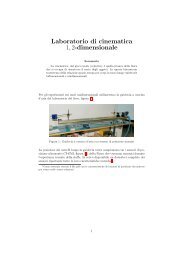Newton's law of cooling revisited - Cartan
Newton's law of cooling revisited - Cartan
Newton's law of cooling revisited - Cartan
You also want an ePaper? Increase the reach of your titles
YUMPU automatically turns print PDFs into web optimized ePapers that Google loves.
1078 M Vollmer<br />
Figure 11. Cooling curves <strong>of</strong> (0.5 l) bottles for a regular fridge, a freezer and an air convection<br />
cooler. The typical timescale for <strong>cooling</strong> from 28 ◦ C to below 14 ◦ C (which may be a suitable<br />
drinking temperature) is about 2 h for the fridge, about 3/4 <strong>of</strong> an hour for the freezer but less than<br />
1/2 h for the air convection cooler.<br />
stable paint to achieve the required high emissivity. Specifically, three sides were covered with<br />
the paint, while the remaining three were left as polished metal (due to the extremely small<br />
values for the Biot number, we still assume a very fast thermal equilibrium within the cube<br />
and describe the total radiative <strong>cooling</strong> to first order using an average value for the emissivity<br />
<strong>of</strong> around 0.45; later experiments performed with all six sides covered with the paint justified<br />
this approach). Sufficient time for the heating was given such that all cubes were in thermal<br />
equilibrium within the oven at a temperature <strong>of</strong> 180 ◦ C. The IR-imaging experiment started<br />
after opening the oven and placing the metal grid with the cubes onto some thermal insulation<br />
on a table. The time needed to do this usually led to a strong <strong>cooling</strong> effect already such that<br />
the maximum temperature differences in this experiment were around 140 K.<br />
Figure 12 depicts two snapshots <strong>of</strong> the <strong>cooling</strong> process.<br />
The smallest cubes cool best as can also be seen in the temperature pr<strong>of</strong>iles as a function<br />
<strong>of</strong> time (figure 13). A thorough discussion on time constants and size effects in this experiment<br />
can be found in [5], here we want to focus on the question whether Newton’s <strong>law</strong> can be used<br />
to describe the results.<br />
For the metal cubes, the Biot numbers follow from the values <strong>of</strong> heat conductivity λ ≈<br />
220 W (m · K) −1 ,sizes = between 20 mm and 60 mm and typical values for heat-transfer<br />
coefficients for free convection (solids to gases) in the range 2–25 W (m 2 K) −1 . We find λ/s<br />
between 11000 W m −2 K and 3667 W m −2 KgivingBi≪ 1, i.e. we can expect a temperature<br />
equilibrium within any <strong>of</strong> the metal cubes. This means that the measured surface temperatures<br />
should quite well resemble the average temperatures.<br />
Using the theory outlined above for the metal cubes, the best fit to the experimental data<br />
was used to find a value for the convective heat-transfer coefficient (which was assumed to<br />
be constant during the <strong>cooling</strong> process). The radiation losses do not involve any additional<br />
parameter since ε is known. Figure 14 depicts the result for the 40 mm cube. The value<br />
αConv = 9Wm −2 K for the best agreement with the data lies in the typical range for convective<br />
heat-transfer coefficients.<br />
Previously it was stated [5] that the cube temperatures as a function <strong>of</strong> <strong>cooling</strong> time can<br />
be fitted extremely well with a simple exponential function. After considering the validity




